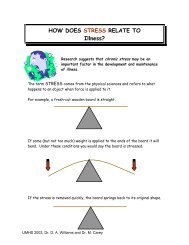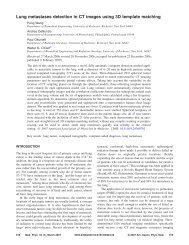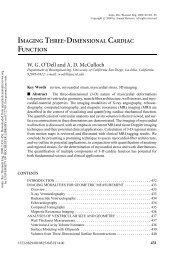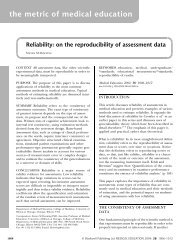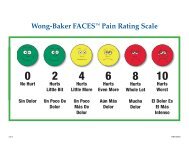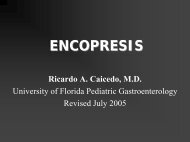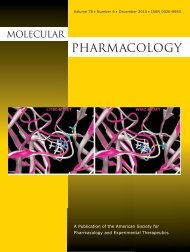A review of the evidence for Prehospital Termination of ...
A review of the evidence for Prehospital Termination of ...
A review of the evidence for Prehospital Termination of ...
You also want an ePaper? Increase the reach of your titles
YUMPU automatically turns print PDFs into web optimized ePapers that Google loves.
How far is too far? A <strong>review</strong> <strong>of</strong> <strong>the</strong> <strong>evidence</strong> <strong>for</strong> <strong>Prehospital</strong> <strong>Termination</strong> <strong>of</strong>Resuscitation after Cardiac ArrestShalu S. Patel, MDChristine Van Dillen MDUniversity <strong>of</strong> Florida-GainesvilleOut-<strong>of</strong>-hospital cardiac arrest (OHCA), whe<strong>the</strong>r traumatic or nontraumatic, has a verylow rate <strong>of</strong> survival to discharge. <strong>Termination</strong> <strong>of</strong> resuscitation (TOR) by EMS has thus been ahighly discussed topic over <strong>the</strong> recent years. Some argue that everything must be done <strong>for</strong>patients with OHCA, while o<strong>the</strong>rs disagree, taking into consideration <strong>the</strong> inherent risk <strong>of</strong> EMSpersonnel during transport and <strong>the</strong> futile use <strong>of</strong> resources which cost millions <strong>of</strong> dollars. In ourlocal ems system, <strong>the</strong> medical care protocol <strong>for</strong> resuscitation <strong>of</strong> cardiopulmonary arrest requiresthat all patients found in cardiopulmonary arrest by EMS personnel receive CPR per AHAstandards. Exceptions to this rule are if <strong>the</strong> patient has a Florida Pre-Hospital DNR order or if<strong>the</strong> patient is “obviously dead,” meaning <strong>the</strong>y are pulseless, apneic, unresponsive and at least one<strong>of</strong> <strong>the</strong> following: absence <strong>of</strong> cardiac activity in 2 or more leads, rigor mortis/cyanosis,decomposition <strong>of</strong> body tissue, decapitation, or destruction <strong>of</strong> <strong>the</strong> brain or heart. Also if CPR hasbeen initiated by a bystander prior to EMS arrival, and <strong>the</strong> patient is determined dead, EMS doesnot have to continue resuscitation. Prior to this <strong>review</strong> in our local EMS system, if resuscitationwas initiated by EMS personnel, it could not be discontinued without physician input via onlinemedical control.Given that TOR protocols differ greatly throughout <strong>the</strong> country, various organizationshave become involved in this debate. They have created guidelines <strong>for</strong> EMS to use in cases <strong>for</strong>which termination <strong>of</strong> resuscitation may be considered. The American Heart Association hasoutlined BLS and ALS termination or resuscitation criteria. For BLS responders, <strong>the</strong> criteria areas follows: (1) arrest unwitnessed by EMS; (2) no defibrillation delivered; (3) no return <strong>of</strong>spontaneous circulation achieved. For ALS responders, <strong>the</strong> criteria are as follows: (1) arrestunwitnessed by EMS or bystanders; (2) no bystander CPR initiated; (3) no defibrillationdelivered; (4) no return <strong>of</strong> spontaneous circulation after full ALS care. These criteria weredeveloped to be used only if <strong>the</strong>y are present on scene, prior to <strong>the</strong> initiation <strong>of</strong> transport to <strong>the</strong>hospital. These guidelines do not account <strong>for</strong> a traumatic arrest, and thus <strong>the</strong> NAEMSP/ACS-COT developed more detailed criteria <strong>for</strong> patients in <strong>the</strong> presence <strong>of</strong> trauma. A copy <strong>of</strong> <strong>the</strong>secriteria can be found on <strong>the</strong> NAEMSP website: http://www.naemsp.org by searching <strong>for</strong>termination <strong>of</strong> resuscitation guidelines in trauma.After extensive <strong>review</strong> <strong>of</strong> <strong>the</strong> literature, it is evident that <strong>the</strong> majority <strong>of</strong> studies are infavor <strong>of</strong> a protocol <strong>for</strong> prehospital termination <strong>of</strong> resuscitation <strong>for</strong> traumatic and nontraumaticcardiac arrest. The data shows that applying <strong>the</strong> BLS criteria has resulted in a high specificityand PPV <strong>for</strong> determining those with poor or no survival, a decrease in EMS transport rate, and asignificant saving in costs. However, individual ethical principles and finding an acceptable“miss rate” are issues that stir up fur<strong>the</strong>r debate.The goal <strong>of</strong> this <strong>review</strong> is to evaluate <strong>the</strong> <strong>evidence</strong> available on <strong>the</strong> different approachesto <strong>the</strong> concept <strong>of</strong> prehospital termination <strong>of</strong> resuscitation by EMS personnel. Ideally in our own
system we plan to provide a medical care protocol to guide <strong>the</strong>m in <strong>the</strong>se difficult decisions.Literature published within <strong>the</strong> last 5 years was used in this <strong>review</strong> in an ef<strong>for</strong>t to keep <strong>the</strong>in<strong>for</strong>mation as up to date and as relevant as possible. The majority <strong>of</strong> <strong>the</strong> studies found in <strong>the</strong>search were retrospective cohort studies or systematic <strong>review</strong>s <strong>of</strong> <strong>the</strong> <strong>evidence</strong>. It would be idealto evaluate <strong>evidence</strong> from randomized-controlled trials, however it is possible that ethicaldilemmas and difficulty obtaining consent have prevented <strong>the</strong>se types <strong>of</strong> studies from beingper<strong>for</strong>med. There<strong>for</strong>e this <strong>review</strong> is limited to studies that do not provide <strong>the</strong> strongest <strong>evidence</strong>.We felt it essential that this <strong>review</strong> include both traumatic and nontraumatic cardiac arrest, aswell as adult and pediatric patients because it best represents <strong>the</strong> population in which EMSpersonnel serve.There were two studies in <strong>the</strong> literature search that presented drawbacks to <strong>the</strong>implementation <strong>of</strong> a protocol <strong>for</strong> prehospital termination <strong>of</strong> resuscitation. The first was aretrospective <strong>review</strong> <strong>of</strong> 89 trauma patients who suffered from ei<strong>the</strong>r blunt or penetrating trauma,received CPR in <strong>the</strong> field, and were taken to <strong>the</strong> hospital <strong>for</strong> fur<strong>the</strong>r management. Four patientssurvived to discharge with 2 <strong>of</strong> which were secondary to blunt trauma. One <strong>of</strong> <strong>the</strong> blunt traumapatients likely arrested from electrocution and <strong>the</strong> o<strong>the</strong>r from hypoxia. Thus, it was concludedthat CPR in <strong>the</strong> field in trauma patients is not always futile, being <strong>the</strong>re were 4 survivors. Theauthors recommended treating patients on a case-by-case basis, especially in cardiac arrests inwhich o<strong>the</strong>r factors such as electrocution and hypoxia may have been involved in <strong>the</strong> cause <strong>of</strong><strong>the</strong> arrest. This study did have several limitations including : a small study sample size, it was aretrospective study, and <strong>the</strong> data collected depended on EMS and hospital documentation (so<strong>the</strong>re were several unknown factors such as transport time and duration <strong>of</strong> arrest). 3 Ano<strong>the</strong>rretrospective cohort analysis evaluated <strong>the</strong> three BLS TOR criteria. Out <strong>of</strong> 2810 patients in <strong>the</strong>study, 1160 met <strong>the</strong> three BLS TOR criteria, and only one survived to hospital discharge. Thus, itwas concluded that <strong>the</strong> BLS TOR criteria can accurately predict those cardiac arrest patients whowill not survive to hospital discharge. 4 However, this study brings up <strong>the</strong> issue <strong>of</strong> finding anacceptable miss rate. In this study, one patient with a good neurological outcome at <strong>the</strong> time <strong>of</strong>discharge would have been missed if <strong>the</strong> BLS TOR criteria had been implemented. Is it ok tomiss one person? How do you put a value on <strong>the</strong> life <strong>of</strong> one person? This issue contributes to<strong>the</strong> fact that protocols regarding termination <strong>of</strong> resuscitation differ throughout <strong>the</strong> country.Only one retrospective study was found that analyzed traumatic arrest in <strong>the</strong> pediatricpopulation. This study evaluated <strong>the</strong> following data: duration <strong>of</strong> CPR, ECG rhythm, presence orabsence <strong>of</strong> a pulse, pupil response, transport times, and o<strong>the</strong>r demographic data. They found thatCPR greater than 15 minutes and fixed pupils were significant variables to distinguish betweensurvivors and nonsurvivors. They found that if <strong>the</strong>se two criteria plus ECG rhythm and absentpulse are applied as a protocol <strong>for</strong> termination <strong>of</strong> resuscitation, <strong>the</strong>y would correctly identify allnonsurvivors. Of course, given <strong>the</strong> rarity <strong>of</strong> pediatric traumatic cardiac arrests, this study onlyanalyzed 30 patients in <strong>the</strong> span <strong>of</strong> 10 years, which is one <strong>of</strong> <strong>the</strong> limitations in <strong>the</strong> study. 5The remaining studies in this <strong>review</strong> found that protocols were beneficial in determiningtermination <strong>of</strong> resuscitation. Many <strong>of</strong> <strong>the</strong> studies confirmed that <strong>the</strong> BLS TOR criteria aresuperior. One study compared <strong>the</strong> BLS TOR criteria, ALS TOR criteria, and Neuro TOR criteriato evaluate rate <strong>of</strong> survival with good neurological functioning. The Neuro TOR criteria are asfollows: (1) cardiac arrest unwitnessed by EMS or bystanders; (2) age >78 years; and (3)asystole. This rule per<strong>for</strong>med poorly in determining appropriate patients <strong>for</strong> termination <strong>of</strong>
esuscitation. 8 Multiple studies in this literature search found that <strong>the</strong> BLS TOR rule, <strong>the</strong> ALSTOR rule, and <strong>the</strong> criteria developed by <strong>the</strong> NAEMSP/ACS-COT had a high PPV <strong>for</strong> death, anduse <strong>of</strong> <strong>the</strong>se rules would significantly decrease EMS transport and overall costs. A more recentstudy demonstrated that patients found in asystole without field ROSC have a negligible chance<strong>of</strong> survival to hospital discharge, suggesting that only patients with a shockable rhythm or thosewith field ROSC should be transported by EMS to a medical facility. This again supports criteriafrom <strong>the</strong> BLS-TOR guidelines. 10Overall, only <strong>the</strong> BLS-TOR rule has been rigorously validated and can be considered inall EMS systems. Fur<strong>the</strong>r studies, especially prospective randomized-controlled trials, wouldmost definitely aid in gaining widespread acceptance <strong>of</strong> this rule. The problem with establishinga rule <strong>for</strong> termination <strong>of</strong> resuscitation is that some people may feel that missing even one personwho could have been potentially saved is unacceptable, no matter <strong>the</strong> savings in costs and risksto EMS personnel. Also <strong>the</strong> definition <strong>of</strong> medical futility should be revisited, and <strong>the</strong>re shouldbe a cost-benefit analysis within individual EMS systems to evaluate whe<strong>the</strong>r this rule, or anyTOR rule, is appropriate <strong>for</strong> implementation.Prior to implementation <strong>of</strong> any protocol, it is important to get <strong>the</strong> EMS personnel andphysicians to agree with <strong>the</strong> protocol. The EMS providers should feel com<strong>for</strong>table withterminating or withholding resuscitation, although this becomes difficult seeing <strong>the</strong>y are trainedto intervene and save lives. The NAEMSP/ACS-COT guidelines <strong>for</strong>med as an agreementbetween EMS physicians and trauma surgeons are well accepted and can be adapted to fitindividual systems. Perhaps <strong>the</strong> TOR criteria can be modified. Fur<strong>the</strong>r research should be aimedat <strong>the</strong> identification <strong>the</strong> circumstances present in <strong>the</strong> rare survivors, so we can always do what isbest <strong>for</strong> our patients and our community. Some exclusion criteria that could be added to <strong>the</strong>current guidelines include: an age range, temperature range, or exposure to drugs, electrocutionor drowning. Also perhaps a limit on scene time + transport time should be incorporated as well.Fur<strong>the</strong>r research would need to per<strong>for</strong>med to confirm whe<strong>the</strong>r <strong>the</strong>se additions would beappropriate.More recent studies are also evaluating <strong>the</strong> role <strong>of</strong> end-tidal CO2 and <strong>the</strong> use <strong>of</strong> cardiac echo toaid in <strong>the</strong> decision to terminate resuscitation. Ano<strong>the</strong>r recently published study noted bloodammonia and lactate levels to be independent predictors <strong>of</strong> favorable outcomes <strong>for</strong> patients withnontraumatic OHCA. 11 All <strong>of</strong> <strong>the</strong>se additional findings need fur<strong>the</strong>r evaluation prior toincluding <strong>the</strong>m in <strong>for</strong>mal TOR criteria.After this <strong>review</strong> our system decided to implement guidelines which allowed EMS personnel todiscontinue resuscitation in <strong>the</strong> field without medical control contact if all <strong>of</strong> <strong>the</strong> followingcriteria are present: patient found in asystole and remained in asystole, ETCO2
admitted to <strong>the</strong> ICU, which decreases ICU bed availability, and many <strong>of</strong> <strong>the</strong>se patients do notsurvive to hospital discharge. Due to severe hypoxia many <strong>of</strong> <strong>the</strong> patients that do survive todischarge are neurologically devastated and are a burden to <strong>the</strong>ir families or are sent to a skillednursing facility. However, it is difficult to ignore how amazing it is when a patient survivesneurologically intact and is able to thank you <strong>for</strong> your help. We cannot diminish <strong>the</strong> value <strong>of</strong>that one person.References1. Sherbino J, Keim SM, Davis DP; BEEM Group. Clinical Decision Rules <strong>for</strong> <strong>Termination</strong> <strong>of</strong>Resuscitation in Out-<strong>of</strong>-hospital Cardiac Arrest. J Emerg Med. 2010;38(1): 80-86.2. Mollberg NM, Wise SR, Berman K, Chowdhry S, Holevar M, Sullivan R, Vafa A. TheConsequences <strong>of</strong> Noncompliance With Guidelines <strong>for</strong> Withholding or TerminatingResuscitation in Traumatic Cardiac Arrest Patients. J Trauma. 2011;71: 997–1002.3. Willis CD, Cameron PA, Bernard SA, Fitzgerald M. Cardiopulmonary resuscitation aftertraumatic cardiac arrest is not always futile. Injury, Int. J. Care Injured. 2006;37: 448-454.4. Richman PB, Vadeboncoeur TF, Chikani C, Clark L, Bobrow BJ. Independent Evaluation <strong>of</strong>an Out-<strong>of</strong>-hospital <strong>Termination</strong> <strong>of</strong> Resuscitation (TOR) Clinical Decision Rule. Acad EmergMed. 2008; 15:517-521.5. Capizzani AR, Drongowski R, Ehrlich PF. Assessment <strong>of</strong> termination <strong>of</strong> trauma resuscitation
guidelines: are children small adults? J Ped Surg. 2010;45: 903-907.6. Sasson C, Hegg AJ, Macy M, Park A, Kellermann A, McNally B; CARES SurveillanceGroup. <strong>Prehospital</strong> termination <strong>of</strong> resuscitation in cases <strong>of</strong> refractory out-<strong>of</strong>-hospital cardiacarrest. JAMA. 2008;300(12):1432-8.7. Morrison LJ, Visentin LM, Kiss A, Theriault R, Eby D, Vermeulen M, Sherbino J, VerbeekPR; TOR Investigators. Validation <strong>of</strong> a rule <strong>for</strong> termination <strong>of</strong> resuscitation in out-<strong>of</strong>-hospitalcardiac arrest. N Engl J Med. 2006;355(5):478-87.8. Ruygrok ML, Byyny RL, Haukoos JS. Validation <strong>of</strong> 3 <strong>Termination</strong> <strong>of</strong> Resuscitation Criteria<strong>for</strong> Good Neurologic Survival After Out-<strong>of</strong>-Hospital Cardiac Arrest. Ann Emerg Med.2009;54: 239-247.9. Stratton SJ and Rashi P. Out-<strong>of</strong>-hospital Unwitness Cardiopulmonary Collapse and NobystanderCPR: A Practical Addition to Resuscitation <strong>Termination</strong> Guidelines. J Emerg Med.2008; 35(2):175-179.10. Wampler DA, Collett L, Manifold CA, Velasquez C, McMullan JT. Cardiac ArrestSurvival is Rare without <strong>Prehospital</strong> Return <strong>of</strong> Spontaneous Circulation. Prehosp Emerg Care.2012.11. . Shinozaki K, Oda S, Sadahiro T, Nakamura M, Hirayama Y, Watanabe E, Tateishi Y,Nakanishi K, Kitamura N, Sato Y, Hirasawa H. Blood ammonia and lactate levels on hospitalarrival as a predictive biomarker in patients with out-<strong>of</strong> hospital cardiac arrest. Resuscitation.2011; 82:404-09.



